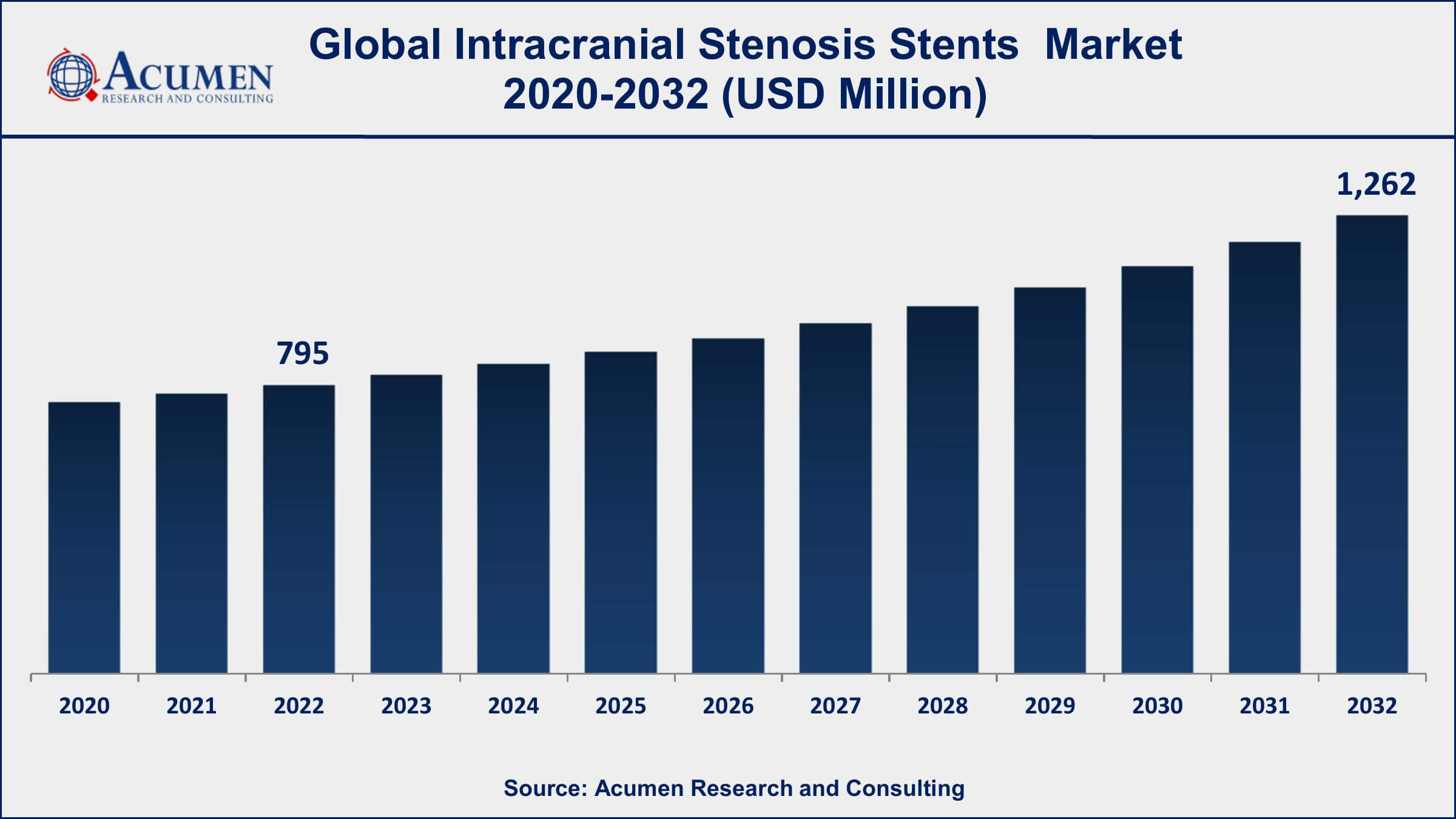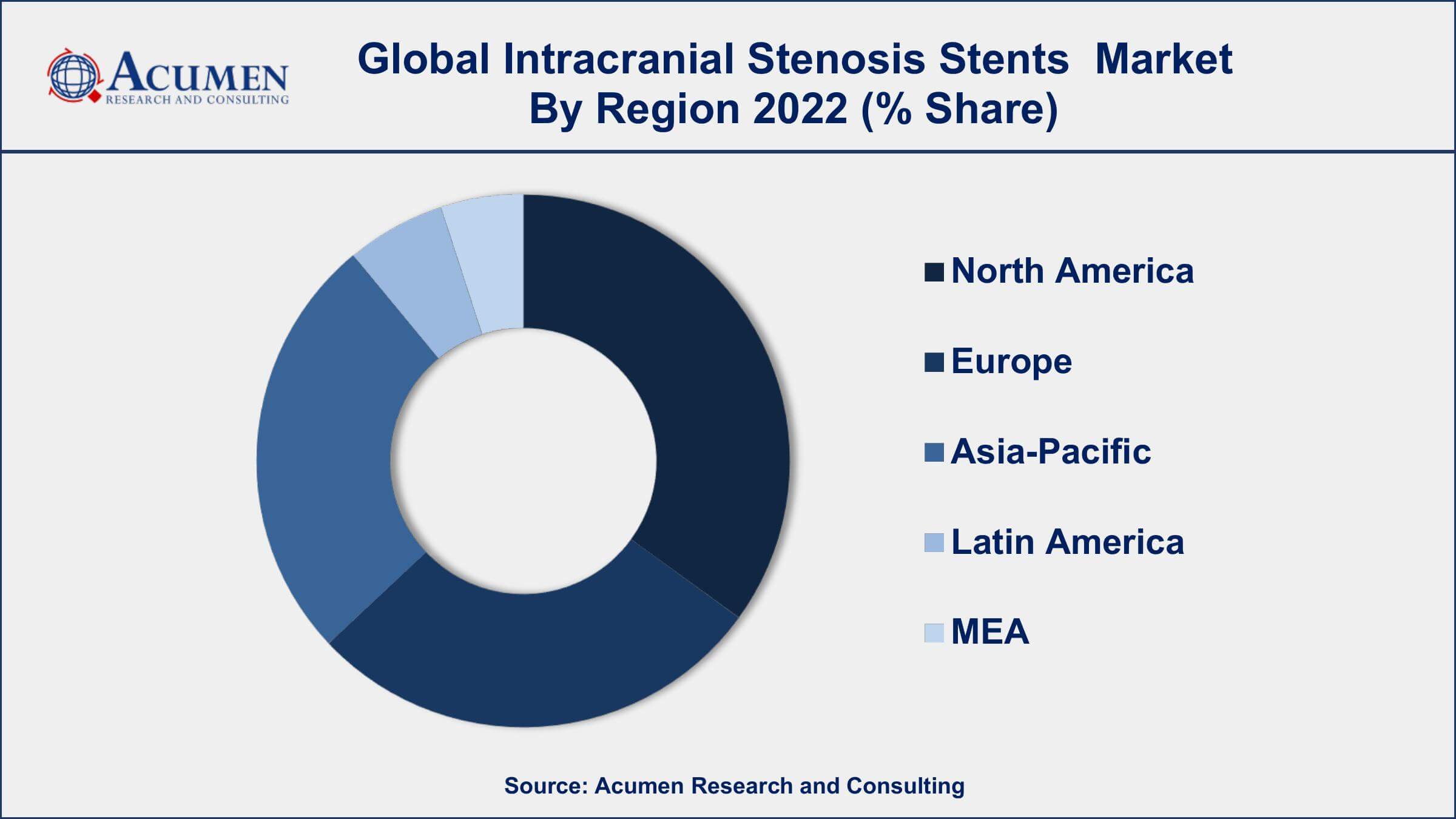Intracranial Stenosis Stents Market Size - Global Industry, Share, Analysis, Trends and Forecast 2023 - 2032
Published :
Report ID:
Pages :
Format :
Intracranial Stenosis Stents Market Size - Global Industry, Share, Analysis, Trends and Forecast 2023 - 2032
Report Coverage
- Industry Dynamics
- Market Size and Forecast Data
- Segment Analysis
- Competitive Landscape
- Regional Analysis with a Niche Focus on Country-Level Data
- High Level Analysis - Porter's, PESTEL, Value Chain, etc.
- Company Profiles of Key Players
- Option to Customize the Report As Per Your Specific Need
Request Sample Report
The Global Intracranial Stenosis Stents Market Size accounted for USD 795 Million in 2022 and is projected to achieve a market size of USD 1,262 Million by 2032 growing at a CAGR of 4.9% from 2023 to 2032.
Intracranial Stenosis Stents Market Highlights
- Global Intracranial Stenosis Stents Market revenue is expected to increase by USD 1,262 Million by 2032, with a 4.9% CAGR from 2023 to 2032
- North America region led with more than 36% of the Intracranial Stenosis Stents Market share in 2022
- Asia-Pacific Intracranial Stenosis Stents Market growth will record a CAGR of more than 6.6% from 2023 to 2032
- By product, the self-expanding stents segment has recorded more than 35% of the revenue share in 2022
- By end-use, the hospitals segment has generated of about 79% of the revenue share in 2022
- Increasing incidence of intracranial stenosis-related conditions like ischemic strokes, drives the Intracranial Stenosis Stents Market value

Intracranial stenosis stents are medical devices designed to treat a condition known as intracranial stenosis, which involves the narrowing of blood vessels within the brain. This narrowing can restrict blood flow to critical areas of the brain, potentially leading to serious neurological complications like strokes. Intracranial stenosis stents are used in a medical procedure called intracranial angioplasty and stenting, where a stent is inserted into the narrowed blood vessel to help keep it open. This procedure aims to improve blood flow and reduce the risk of stroke by preventing clot formation and maintaining adequate circulation in the affected brain region.
The market for intracranial stenosis stents has witnessed growth due to several factors. As the aging population increases and the prevalence of risk factors such as hypertension, diabetes, and atherosclerosis rises, the incidence of intracranial stenosis-related conditions like ischemic strokes also increases. This has driven the demand for effective treatment options, including intracranial stenosis stents. Advances in stent technology, such as the development of self-expanding and drug-eluting stents, have improved the outcomes of the angioplasty and stenting procedure, further contributing to market growth. Additionally, growing awareness among healthcare professionals about the benefits of early intervention and improved diagnostic techniques has led to higher diagnosis rates and subsequently increased demand for treatment options, bolstering the intracranial stenosis stents market.

Global Intracranial Stenosis Stents Market Trends
Market Drivers
- Increasing incidence of intracranial stenosis-related conditions like ischemic strokes
- Growing aging population and associated risk factors
- Advancements in stent technology, including self-expanding and drug-eluting stents
- Rising awareness among healthcare professionals about the benefits of early intervention
- Improved diagnostic techniques leading to higher diagnosis rates
Market Restraints
- Stringent regulatory approvals and compliance requirements for medical devices
- Potential complications associated with the stenting procedure
Market Opportunities
- Untapped potential in emerging markets with increasing healthcare infrastructure
- Development of innovative stent designs for enhanced safety and efficacy
Intracranial Stenosis Stents Market Report Coverage
| Market | Intracranial Stenosis Stents Market |
| Intracranial Stenosis Stents Market Size 2022 | USD 795 Million |
| Intracranial Stenosis Stents Market Forecast 2032 | USD 1,262 Million |
| Intracranial Stenosis Stents Market CAGR During 2023 - 2032 | 4.9% |
| Intracranial Stenosis Stents Market Analysis Period | 2020 - 2032 |
| Intracranial Stenosis Stents Market Base Year | 2022 |
| Intracranial Stenosis Stents Market Forecast Data | 2023 - 2032 |
| Segments Covered | By Product, By End-use, And By Geography |
| Regional Scope | North America, Europe, Asia Pacific, Latin America, and Middle East & Africa |
| Key Companies Profiled | Medtronic, Stryker Corporation, Abbott Laboratories, Boston Scientific Corporation, Terumo Corporation, MicroPort Scientific Corporation, Balt Extrusion, Acandis GmbH, InspireMD, Rapid Medical, Phenox GmbH, and Penumbra, Inc. |
| Report Coverage |
Market Trends, Drivers, Restraints, Competitive Analysis, Player Profiling, Covid-19 Analysis, Regulation Analysis |
Intracranial stenosis stents are specialized medical devices designed to address a condition called intracranial stenosis, which involves the narrowing of blood vessels within the brain. This narrowing occurs due to the build-up of plaque, cholesterol, and other substances on the inner walls of the arteries. Intracranial stenosis can lead to reduced blood flow to vital areas of the brain, increasing the risk of ischemic strokes and other neurological complications.
The application of intracranial stenosis stents lies in the realm of neurointerventional procedures. When medical management alone is insufficient, neurosurgeons and interventional radiologists employ these stents in a procedure known as intracranial angioplasty and stenting. During this procedure, a tiny stent is carefully inserted into the narrowed blood vessel using minimally invasive techniques. Once in place, the stent expands and reinforces the artery walls, preventing them from collapsing and ensuring improved blood flow to the brain. This intervention helps in reducing the risk of strokes, enhancing the patient's neurological well-being, and potentially avoiding the need for more invasive surgical procedures.
The intracranial stenosis stents market has experienced steady growth due to a confluence of factors driving demand for these specialized medical devices. As the global population ages, the incidence of conditions related to intracranial stenosis, such as ischemic strokes, has increased. This demographic shift has led to a higher demand for effective treatments that can improve blood flow to the brain and reduce the risk of life-threatening complications. The advancement of stent technology, including the development of self-expanding and drug-eluting stents, has improved the outcomes of intracranial angioplasty and stenting procedures, making them more effective and safer. These technological advancements have further fueled the growth of the market, attracting both healthcare professionals and patients seeking better treatment options. Moreover, the growing awareness among healthcare providers about the benefits of early intervention in intracranial stenosis cases has contributed to the expansion of the market.
Intracranial Stenosis Stents Market Segmentation
The global Intracranial Stenosis Stents Market segmentation is based on product, end-use, and geography.
Intracranial Stenosis Stents Market By Product
- Self-expanding Stents
- Venous Sinus Stents
- Embolization Coil Support Intracranial Stents
- Balloon-expanding & Other Stents
In terms of products, the self-expanding stents segment accounted for the largest market share in 2022. The growth of the self-expanding stents segment can also be attributed to improved patient outcomes. These stents offer better vessel support, reducing the likelihood of complications like restenosis (re-narrowing of the vessel) and stent migration. Additionally, self-expanding stents are often combined with drug-eluting technologies, enabling the controlled release of medication that further prevents vessel re-narrowing. These advantages have led to higher success rates in maintaining adequate blood flow to the brain, which is essential in preventing strokes and other neurological complications. With ongoing research and development in stent materials, designs, and coatings, the self-expanding stents segment is expected to continue its growth trajectory within the intracranial stenosis stents market.
Intracranial Stenosis Stents Market By End-use
- Hospitals
- Ambulatory Surgical Centers
- Others
According to the intracranial stenosis stents market forecast, the hospitals segment is expected to witness significant growth in the coming years. Hospitals serve as essential centers for comprehensive medical care, equipped with advanced diagnostic tools, skilled healthcare professionals, and specialized facilities required for performing intricate procedures like intracranial stenosis stenting. The growth of the hospitals segment is further bolstered by collaborations between medical device manufacturers and healthcare institutions. Such collaborations facilitate knowledge exchange, technology sharing, and training opportunities for medical professionals, leading to improved clinical outcomes. Moreover, the availability of diverse expertise within hospitals, including interventional radiologists, neurologists, and vascular surgeons, allows for a multidisciplinary approach to patient care. This collective expertise enhances the success of intracranial stenting procedures and contributes to positive patient experiences.
Intracranial Stenosis Stents Market Regional Outlook
North America
- U.S.
- Canada
Europe
- U.K.
- Germany
- France
- Spain
- Rest of Europe
Asia-Pacific
- India
- Japan
- China
- Australia
- South Korea
- Rest of Asia-Pacific
Latin America
- Brazil
- Mexico
- Rest of Latin America
The Middle East & Africa
- South Africa
- GCC Countries
- Rest of the Middle East & Africa (ME&A)

Intracranial Stenosis Stents Market Regional Analysis
North America's dominance in the intracranial stenosis stents market can be attributed to a combination of factors that create a conducive environment for market growth. One key factor is the region's well-established healthcare infrastructure, which includes advanced medical facilities, cutting-edge technology, and a robust network of healthcare professionals. These resources facilitate timely diagnosis, effective treatment, and favorable patient outcomes, positioning North America as a hub for medical innovation and intervention. Moreover, the prevalence of risk factors associated with intracranial stenosis, such as hypertension, diabetes, and high cholesterol, is relatively high in North America. This contributes to a larger patient pool in need of medical interventions, driving demand for intracranial stenosis stents. Additionally, the region's strong emphasis on medical research and development has led to the creation of innovative stent technologies that cater to the specific needs of patients with intracranial stenosis, further propelling market growth. The supportive regulatory environment in North America also plays a crucial role. Stringent regulatory processes ensure that medical devices, including intracranial stenosis stents, meet rigorous safety and efficacy standards before entering the market.
Intracranial Stenosis Stents Market Player
Some of the top intracranial stenosis stents market companies offered in the professional report include Medtronic, Stryker Corporation, Abbott Laboratories, Boston Scientific Corporation, Terumo Corporation, MicroPort Scientific Corporation, Balt Extrusion, Acandis GmbH, InspireMD, Rapid Medical, Phenox GmbH, and Penumbra, Inc.
Frequently Asked Questions
What was the market size of the global intracranial stenosis stents in 2022?
The market size of Intracranial Stenosis Stents was USD 795 Million in 2022.
What is the CAGR of the global intracranial stenosis stents market from 2023 to 2032?
The CAGR of intracranial stenosis stents is 4.9% during the analysis period of 2023 to 2032.
Which are the key players in the intracranial stenosis stents market?
The key players operating in the global market are including Medtronic, Stryker Corporation, Abbott Laboratories, Boston Scientific Corporation, Terumo Corporation, MicroPort Scientific Corporation, Balt Extrusion, Acandis GmbH, InspireMD, Rapid Medical, Phenox GmbH, and Penumbra, Inc.
Which region dominated the global intracranial stenosis stents market share?
North America held the dominating position in intracranial stenosis stents industry during the analysis period of 2023 to 2032.
Which region registered fastest CAGR from 2023 to 2032?
Asia-Pacific region exhibited fastest growing CAGR for market of intracranial stenosis stents during the analysis period of 2023 to 2032.
What are the current trends and dynamics in the global intracranial stenosis stents industry?
The current trends and dynamics in the intracranial stenosis stents market growth include increasing incidence of intracranial stenosis-related conditions like ischemic strokes, growing aging population and associated risk factors, and advancements in stent technology.
Which product held the maximum share in 2022?
The self-expanding stents product held the maximum share of the intracranial stenosis stents industry.


